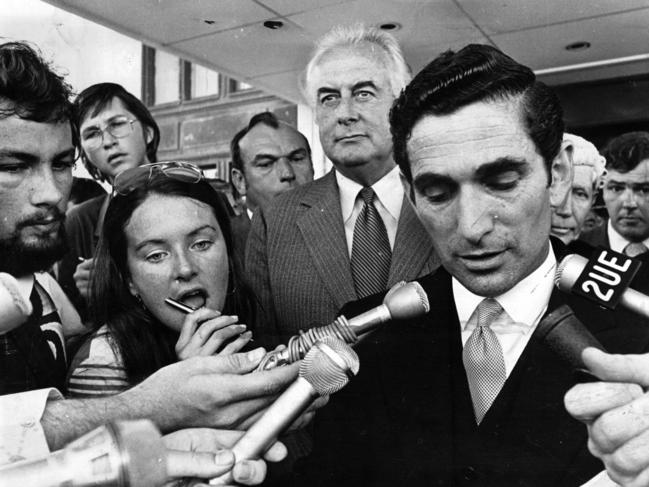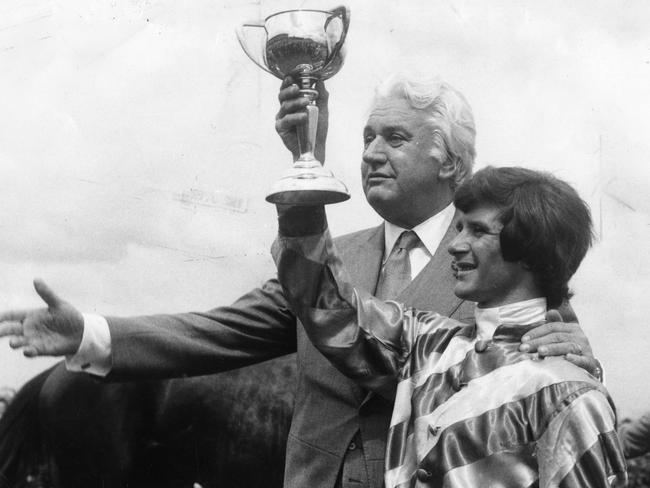Gough Whitlam dismissal: ‘Palace Letters’ reveals whole story
The Queen was not told in advance that former governor-general Sir John Kerr would dismiss the Whitlam government, new letters reveal.
Queen Elizabeth II was not told in advance that former governor-general Sir John Kerr would dismiss the Whitlam government, new letters reveal.
In the anticipated Palace Letters released on Tuesday by the National Archives, Sir John wrote he did not give the monarch notice because “it was better for Her Majesty not to know”.
“I should say I decided to take the step I took without informing the Palace in advance because, under the Constitution, the responsibility is mine, and I was of the opinion it was better for Her Majesty not to know in advance, though it is of course my duty to tell her immediately,” Sir John wrote to the Palace.
A return letter from the Queen’s private secretary, Sir Martin Charteris, received on November 17, 1975, states: “Thank you very much for your letter of the 11th of November, which I of course showed to the Queen as soon as possible after it arrived.”
“If I may say so with the greatest respect, I believe in not informing the Queen of what you intended to do before doing it, you acted not only with constitutional propriety, but also with admirable consideration for Her Majesty’s position,” Sir Martin wrote.

In a letter dated November 20, Sir John wrote a full account of everything that went into his decision to sack Mr Whitlam, revealing what informed his decision.
“History will doubtless provide an answer to this question, but I was in a position where, in my opinion, I simply could not risk the outcome for the sake of the monarchy,” he wrote.
“If, in the period of 24 hours in which he (Whitlam) was considering his position he advised the Queen that I should be immediately dismissed, the position would then have been that either I would be, in fact, trying to dismiss him while he was trying to dismiss me — an impossible position for the Queen.”
In response, the Palace wrote it was the “most convincing account of the psychological and actual pressures to which you were subject when you took action on 11th November”.
“I still have not found anyone here with knowledge prepared to say what else you could have down.”
More than 200 secret letters between the Queen and Sir John were released on Tuesday morning, shedding light on what really happened during the dismissal of Prime Minister Gough Whitlam.
Mr Whitlam was dismissed without warning on November 11, 1975, about a month after the Senate refused to pass the Government’s budget bills.
Malcolm Fraser, then opposition leader, was appointed caretaker prime minister, and a double-dissolution election was held on December 13, where the Whitlam Government was defeated.
Prior to the election the Palace advised Sir John against making any statements about the future of his tenure as governor-general.
Sir John went on to serve for another two years before standing down in December 1977.

REVELATIONS ARE ‘QUITE SCANDALOUS’
The Palace Letters contain conversations between Sir John Kerr and Buckingham Palace that were “quite scandalous”, the historian who fought a four-year legal battle to have them publicly released said.
Professor Jenny Hocking said it was “not appropriate” for the governor-general to be discussing the extent of his powers to sack the Prime Minister of the day, referred to as the Reserve Powers, with the palace.
“(Sir Martin) advises the governor-general on the nature and the powers and the potential use of the Reserve Powers,” she said after the release of the papers on Tuesday afternoon.
“(The Reserve Powers) is highly contested — some would claim it doesn’t exist at all.
“For the Queen’s private secretary to be commenting, to the governor-general, who was about to exercise those powers, on the existence and possible use (of them), I think is alarming.”
She said it was especially “troubling” that Sir John discussed those powers with Buckingham Palace, at the same time he was ignoring the option of taking the advice of the relevant Australian figures: the solicitor-general and the attorney-general.
“He is instead taking advice from the Queen’s private secretary,” she said. “There is no doubt the palace was aware of the prospect of dismissal.”
It was inevitable that the contents of the letters would make Australians think carefully about the role of the monarchy in Australian politics, given the “arcane” legal basis for the dismissal — the Reserve Powers — Professor Hocking said.
Especially because “the depth of discussion” between the monarchy and Sir John Kerr had been revealed.
“What reason is there that a head of state — a nonresident in Australia — having any sort of conversations, much less influence, over such a dramatic decision?” she said.
She said while she expected the revelation that Sir John dismissed Mr Whitlam without the express prior knowledge of the queen, she did not expect to find him seeking advice on whether or not he had the power to do so with Buckingham Palace.
Out of the 1200 pages of the Palace Letters, it “jumped out” to Professor Hocking that Sir John was discussing with Prince Charles his fears for his own position and that Mr Whitlam could dismiss him, in September 1975.
She said the “really startling thing” about the Palace Letters was the extent with which Sir John Kerr was discussing domestic Australian politics with the queen, through her private secretary.
The other surprising feature of the letters for Professor Hocking was their sheer number: over 200 letters across over 1200 pages. “That’s really extraordinary,” she said. “Normally, a Governor-General would be reporting to the palace maybe only annually, perhaps as much as quarterly. To be sending this number of letters does show that very close interaction between the Palace and the governor-general at that time, over matters there were intensely and profoundly political.”
The Governor-General had at times written to Buckingham Palace more than once a day, with his correspondence reportedly becoming more feverish in the lead-up to the dismissal.
In two letters between October 20-24, 1975 Sir John outlined constitutional and political problems to the Palace, and revealed he felt under pressure to act as Mr Whitlam refused to call an election.
On November 4 it responded writing: “The Queen read it with much interest and also with much concern for the pressures to which you are being subjected by the crisis.”
“With the greatest respect, I am sure you are right in taking the line that your crisis has not yet crossed the threshold from the political into the constitutional arena,” Sir Martin wrote.
“Mr Fraser wants to believe it is a ‘constitutional crisis’ because he wants you to bring about an election which he thinks he can win.”
He went on to write: “I think you are playing the ‘Vice-Regal’ hand with skill and wisdom. Your interest in the situation has been demonstrated and so has your impartiality.
“The fact that you have powers is recognised, but it is also clear that you will only use them in the last resort and then only for constitutional and not for political reasons.”
The National Archives of Australia and the Federal court had deemed the letters personal communications, which prevented them from being released until 2027 and only with the Queen’s permission.
But a lengthy court battle led by Professor Hocking reclassified the documents as Commonwealth property in June despite a fight from the Palace to keep them a secret.
National Archives director-general David Fricker said the release of the documents was a special event.

Mr Fricker described the former governor-general as a “very chatty” correspondent.
“He does detail state visits. He goes into some Commonwealth-state relations issues, which you won’t be surprised we still face today,” Mr Fricker said.
“And, of course, the dismissal. What’s in there? Typically, letters – several pages long – from Sir John, who is just giving a roundup of what’s going on in Australia at the time.
“In almost every case, he’s attached newspaper clippings from the day, which provide that additional analysis for the information of the Palace to explore the background to the various achievements.”
Mr Fricker also acknowledged the “perseverance and dedication” of Professor Hocking.

Prof Hocking spent four years fighting through the courts to have the documents made public, after first seeking access to the files a decade ago.
The National Archives of Australia record search crashed barely half an hour after the documents went online following “higher than usual traffic”.
Labor’s republic spokesman, Matt Thistlewaite, said once Australia gets through the COVID-19 crisis, it must begin a “mature and serious discussion” about future constitutional arrangements with a view to appoint an Australian as our head of state.
“What these letters reveal is that our unelected head of state, on the other side of the world, was advising the Governor-General on how to remove our elected Prime Minister – and never once thought to tell the elected Prime Minister what was being planned,” he said in a statement with Labor MP Mark Dreyfus.
“Just one week before the dismissal, The Queen’s Private Secretary, Sir Martin Charteris, advised the Governor-General he had the power to sack the elected Australian Prime Minister.
“These letters confirm once again that Australia needs our own head of state.”


